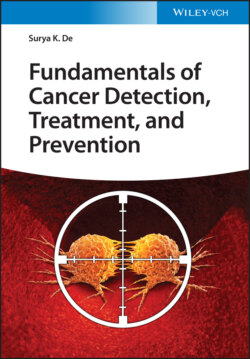Читать книгу Fundamentals of Cancer Detection, Treatment, and Prevention - Surya K. De - Страница 71
2.9 Role of Smoking or Tobacco Use on Cancer
ОглавлениеTobacco use is one of the leading causes of cancer and cancer mortality. People who smoke or use tobacco products, or who are regularly around environmental tobacco smoke known as “secondhand smoke,” have a proven, increased risk of developing cancer. Tobacco products contain more than 70 chemicals that damage DNA [36–72]. According to the Centers for Disease Control and Prevention (CDC), nonsmokers exposed to secondhand smoke at home or at work increase their risk of developing lung cancer by 20–30%.
Tobacco use has been linked to several types of cancer, including that of the lungs, larynx (voice box), mouth, esophagus, throat, bladder, kidney, liver, stomach, pancreas, colon and rectum, and cervix, as well as acute myeloid leukemia (Figure 2.8). Even people who use smokeless tobacco (snuff or chewing tobacco) are more susceptible than nontobacco users to cancers of the mouth, esophagus, and pancreas.
Figure 2.8 Negative bodily effects of smoking.
There is no safe level of tobacco use, and it is recommended that anyone using any kind of tobacco product stop immediately. The tobacco industry has been known to minimize the risk, but obviously, an individual consumer's health is not their priority. Fortunately, those who quit smoking, regardless of their age and gender, increase their life expectancy substantially over people who continue to smoke. Furthermore, quitting smoking at the time of a cancer diagnosis significantly reduces an individual's risk of dying.
